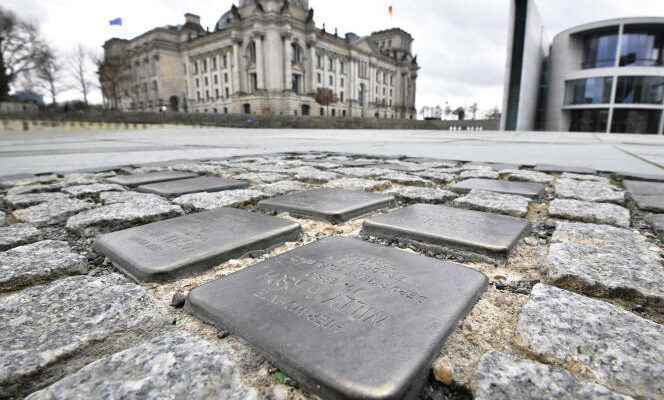LETTER FROM BERLIN
All Germans know the Stolpersteine, (literally: “stones on which one stumbles”), these small cobblestones covered with a brass plate on which is engraved the name of a victim of Nazism. There are 8,802 of them on the sidewalks of Berlin alone, including fifty-six in front of 92 Wilhelmstrasse, the seat of the Ministry of Foreign Affairs from 1870 to 1945.
Installed on November 7, 2021, these fifty-six cobblestones “pay tribute to the personnel of the Ministry of Foreign Affairs who were persecuted by the National Socialists because of their faith, their origin, their ancestry, their political commitment, their sexual orientation or their vision of the world”as can be read on the inscription that heads them.
But all those who figure on these fifty-six Stolpersteine do they really deserve such an honor? This is the question raised the weekly Last Spiegelend of Julyin an investigation claiming that at least three of them were Nazi sympathizers.
So with Georg von Broich-Oppert. On the pavement that pays homage to him, it is written that he was “compulsorily retired in 1935”. The article of Spiegel specifies that this diplomat, sent to Vienna in 1932, a few months before the Nazis came to power, was then dismissed from the civil service because his father had “parents of Jewish descent”.
But, according to the weekly, a Nazi lawyer did everything to plead his case, going so far as to assure under oath that he had rendered invaluable service to the NSDAP [le parti nazi] and the SAs [sections d’assaut hitlériennes] »adding that he had “led his life in Vienna in the spirit of National Socialism”.
“The backgrounds of these people must be re-examined”
Second name that raises questions: Alfred Lütgens. Appointed Consul General in Poznan, Poland, in 1928, he too was “compulsorily retired in 1935”can we read on his Stolpersteinand this, because he also had “Jewish blood”specifies the Spiegel.
As the weekly reveals, however, his personal file contains the testimony of a “NSDAP confidant” who defended him by declaring: “We could not have had a better National Socialist in this position. (…) having always acted with his country and his Führer, Adolf Hitler, in mind. »
Third example: Rudolf Holzhausen, stationed in Prague since 1928. On the pavement that bears his name, we read that he was struck off in 1934. The Spiegel quotes, however, a document in which the Minister of Foreign Affairs at the time, Konstantin von Neurath, assures that this diplomat “worked confidently with German community leaders”. Retired because his wife was a “half-Aryan”the person concerned would have himself affirmed “having had very close ties with the National Socialist Federation of Sudeten Germans”a region of Czechoslovakia that was annexed by the IIIe Reich in the fall of 1938.
You have 57.21% of this article left to read. The following is for subscribers only.
